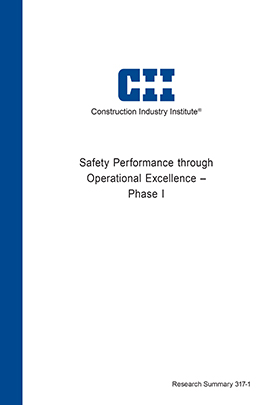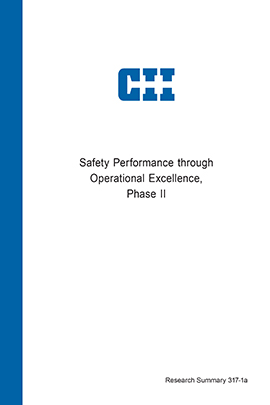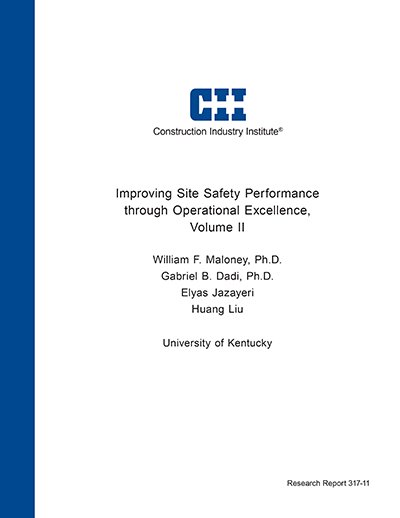
Safety Performance through Operational Excellence -- Phase I
The Construction Industry Institute (CII) chartered Research Team 317 (RT-317) to identify the impact of operational excellence on safety performance. Recognizing the challenge of this task, CII authorized RT-317 to divide its project into two phases. The primary objective of Phase I was to develop a conceptually validated model of operational excellence for safety in the context of a construction project. The results of this phase are summarized in this research summary and described more completely in Research Report 317-11, Improving Site Safety Performance through Operational Excellence. RT-317 continues its work in Phase II, collecting data to measure the relationship between operational excellence and safety performance, and then quantifying the impact of adherence to the operational excellence model on project safety performance.
“Doing the right thing, the right way, every time – even when no one is watching.”
Research Team 317’s definition of operational excellence guided its research into developing a rigorous model for construction project safety. Such a model has multiple levels, with the highest level determining which elements drive a project towards operational excellence, and its lowest level identifying specifications and measurements that quantify those elements. RT-317’s initial efforts resulted in the Operational Excellence Model for Construction Project Safety, an extensive model with over 300 specifications and measurements. After multiple assessments and modifications within the research team, the model was scrutinized by 92 owner and contractor industry experts from all levels of their organizations and from all sectors of the capital projects delivery industry. The RT-317 deliverable is a conceptually validated model that synthesizes previous work from fields as varied as psychology, sociology, behavioral safety, organizational culture, Six Sigma, and Quality Function Deployment. The model prescribes the elements necessary to drive behavior, and the consistent execution of desired behaviors should improve safety outcomes.
Operational excellence is a term that is relatively new and poorly defined in the construction industry. Fundamentally, operational excellence in construction can be defined as “doing the right thing, the right way, every time – even when no one is watching.”
RT-317 utilized a “Critical to Quality (CTQ)” tree as the framework for the operational excellence model. Drawing upon literature, expert interviews, and a validation survey, the team developed and presented a rigorous model.
- Recognition and Reward
- Employee Engagement
- Subcontractor Management
- Training and Competence
- Risk Awareness, Management, and Tolerance
- Learning Organization
- Human Performance
- Transformational Leadership
- Shared Values, Beliefs, and Assumptions
- Strategic Safety Communication
- Just and Fair Practices and Procedures
- Worksite Organization
- Owner’s Role
Operational Excellence in regards to safety seeks to formalize and professionalize the concept of safety on construction projects. This requires holistic and significant dedication. Thus, the model of operational excellence is significant and broken down into multiple layers of detail as seen below. OED are operational excellence drivers as outlined in Key Finding #2. CTS (Critical to Safety) are more detailed procedural elements at the project level. CTX (Critical to Expectations) are even more detailed practices at the site level. S/M are specification/measurements or the actual measurable results of your safety policies. The table below provides a count of each layer of the model underneath a specific OE driver.



